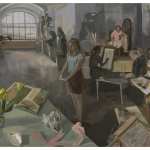�Painting is very private and personal….There�s an emotional content, but I�m more involved in the light and color and drawing of a painting. I don�t set out to portray an emotion.�
Frankenthaler, 83, had died. She lived in a seaside home in Darien, Connecticut, and according to the New York Times, had struggled with a
lengthy illness. Frankenthaler was best known for pouring thinned paint
directly on unprimed canvas, creating big stains of thinned color,
which later came to be known as Color Field Painting. I wasn’t familiar
with her achievements until I read numerous obituaries which credit
Frankenthaler with building a bridge from Abstract Expressionism to
Minimalism. The image below is from a series of prints Frankenthaler
made with Pace Editions in 2007. To my eye, it looks pretty damn contemporary for someone who has been painting since the 1950s. Perhaps the painting is all the same–it’s just the discourse that has changed.
Grace Glueck writes in the NYTimes:
Refining a technique, developed by Jackson Pollock, of pouring pigment
directly onto canvas laid on the floor, Ms. Frankenthaler, heavily
influencing the colorists Morris Louis and Kenneth Noland, developed a
method of painting best known as Color Field
� although Clement Greenberg, the critic most identified with it,
called it Post-Painterly Abstraction. Where Pollock had used enamel that
rested on raw canvas like skin, Ms. Frankenthaler poured
turpentine-thinned paint in watery washes onto the raw canvas so that it
soaked into the fabric weave, becoming one with it. Her staining method emphasized the flat surface over illusory depth, and
it called attention to the very nature of paint on canvas, a concern of
artists and critics at the time. It also brought a new, open airiness
to the painted surface and was credited with releasing color from the
gestural approach and romantic rhetoric of Abstract Expressionism.
Jerry Saltz writes at Vulture:
She blurred the borders between geometry, order, chaos, the body,
atmosphere, and ground. She shunned the overemotional hysteria of
Abstract Expressionism, pouring thinned, watered down, and
turpentine-laden mixes of color directly onto raw canvas. Her structures
and shapes were open, controlled by natural forces while also
describing them. Her paint and canvass became one surface. This was a
big deal back in the day. Edges evaporated; accident was visible; so
were her means and intentions. Pooling paint created varying viscosities
of thickness and thinness; paint dried into imagistic river beds,
isolated islands, clouds, continental masses that all evoked landscape
without depicting it or engaging any abstract sublime. There was no
paint-flinging or implied dance around the canvas. There was
picture-making, pure and simple. And beauty. Lots of it. Which of course
made people run back to labels like feminine.
And that wraps up our posts for 2011. See you next year.
——-
Subscribe to Two Coats of Paint by email.














